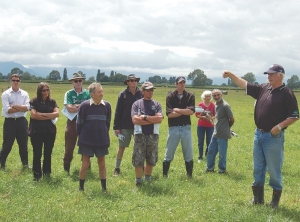The Tatua Cooperative supplier’s good pasture management practices are delivering results. His farm is in the top 5% of farms ranked on profitability on DairyBase, an online software tool that analyses farm businesses.
The Morrinsville farm was also one of the two winners in the Pasture Renewal Persistence Competition, run by the DairyNZ-led Pasture Renewal Leadership Group. The competition set out to find Waikato and Bay of Plenty’s best renewed dairy pastures. Muggeridge’s farm was picked for the quality of its three-year-old pastures, the result of good management before and after sowing, and subsequently.
Judges found high levels of white clover and low weed contents in the winning paddock. They said the success of the pastures, established in 2009, came down to good grazing management, careful pre-sowing preparation and a correct choice of endophyte (AR37).
Muggeridge says he opted for Commando AR37, a diploid perennial ryegrass, sown with Tribute and Emerald white clover. Last month he hosted a fielday on his farm to share his success story with 40 other farmers.
The wining paddock was converted from old pasture in 2009 following the removal of a hedge. Muggeridge says he did not rush the pasture establishment process.
“The paddock was grazed and then sprayed with Round-up before being ploughed. We waited for rain to lift soil moisture, then power harrowed, rolled, sowed and rolled again the same day.”
The first grazing involved 160 cows but only after the pasture passed the ‘pluck test’. The cows had about two hours in the paddock and were removed once a residual of 1500kg DM/ha was achieved.
The second grazing was during a winter round of 90 days, the cows going in when cover reached 2500kg DM/ha, again grazing down to 1500kg DM/ha.
Muggeridge says maintaining paddock quality is the key.
“The cows are monitored while in paddocks at all times during wet weather to ensure paddocks are not being damaged. If there are signs of pugging the cows are stood off on the feed pad. I believe in an absolutely no pugging policy.”
Feed deficits are filled with PKE or silage. Muggeridge and his wife Mary have owned the 90ha (effective) farm since 2006. They run 270 cows and target 110,000kgMS this season. Contract milkers Ashley and Andrew Kowalski have been on the farm since June 2011.
Muggeridge has a five-year plan for the farm that includes pasture renewal, even though pastures are still producing well. Regrassing what turned out to be the winning paddock has taught them some valuable lessons, he says.
“Don’t rush the seedbed preparation… A firm seedbed and compaction is crucial.” Also wait for adequate soil moisture to get a high germination.
Once the sward is established, maintaining paddock quality and regular monitoring to prevent damage is crucial.

















